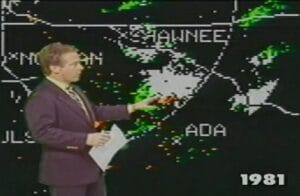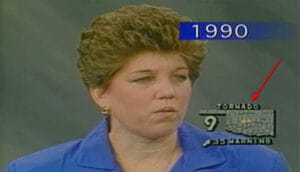Born in Oklahoma, England was 8 years old when the Glazier–Higgins–Woodward tornado outbreak spawned at least 12 tornados from a single supercell, “several” of which were “significant,” over a period of three days. One was at least at times 2 miles wide, and traveled 98 miles from Texas into Oklahoma. The outbreak killed around 185 people and injured nearly a thousand more, and spawned one other thing: a fascination in the young England about the power of weather. Not just tornadoes, but also blizzards, dust storms, flash floods, and wildfires, all of which he witnessed. He joined the U.S. Navy, where he studied weather and, after discharge, earned his B.S. in mathematics with a meteorology “option” from the University of Oklahoma. Why math? At the time they didn’t have a meteorology degree. Since then they’ve woken up, and today the university is home of the National Weather Center, a confederation of federal, state, and academic organizations that work together to better understand weather events.
After working for four years with a consulting company in New Orleans, England went back to Oklahoma to work at a radio station. Shortly after, in 1972, he switched to television — KWTV in Oklahoma City — and convinced station management to get its own weather radar: the world’s first commercial Doppler radar system at a TV station. A year later, England cut into programming to warn of an F4 tornado bearing down on Union City, west of OKC. Viewers could watch the tornado’s progress as it did significant damage to that city. England’s reporting was so effective and useful, the station used clips from the report for years in its promos.

In 1981, while on the air and looking at the station’s radar, England became the first TV weatherman ever to issue a tornado warning based on his station’s own radar system. “That moment marked a turning point in weather broadcasting,” the station said last week. “Doppler radar, which allowed meteorologists to detect wind velocity and rotation inside storms, would go on to be adopted by local TV stations nationwide — nearly a decade before the National Weather Service rolled out its own NEXRAD Doppler network.”

But what about severe weather warnings other than tornados? Especially events that happen outside newscast hours? In 1990, England developed First Warning, which could overlay basic warning information onto the TV screen without even interrupting the TV show being broadcast. It could quickly provide alerts even if there was no meteorologist on duty who could cut in and provide reporting. That innovation also quickly spread to local stations nationwide.
In 1991, England created StormTracker, a system that didn’t just show on a map overlay where storms were coming from, but where they were going, with predicted arrival times so viewers in the path could know to head for storm shelters in time, which also spread to other stations. When the 1996 film Twister was under development, producers brought England in as a consultant. He also appeared in the film, including its opening scene (via archive clips of his reporting on actual tornados), as one of three TV meteorologists in the film. And in 1999, he helped develop storm warning systems on a new medium, the Internet, sending alerts directly to online users. After the May 3, 1999, tornado outbreak, he appeared in over 50 national and international weather specials, describing how two supercells spawned 152 tornadoes from Oklahoma to southern Canada, including 70 in Oklahoma alone. It was Oklahoma’s worst tornado outbreak in recorded history.
England retired from broadcast work in 2013, after 41 years on the air at KWTV. “I’ve heard people say, ‘Gary England saved my life’,” said NOAA spokeswoman Keli Pirtle, shortly before he retired. A local blog voted England “the most influential person in the state” — ahead of Jesus. In May, England suffered a stroke, then entered hospice care, and died in Oklahoma City on June 10. He was 85.
